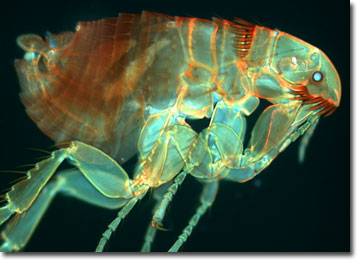Fluorescence Digital Image Gallery
Fleas
Ctenocephalides felis is commonly known as the cat flea and Ctenocephalides canis is known as the dog flea. Both are members of the 1,600 species referred to as fleas, order Siphonaptera ("wingless siphon"). These blood-sucking insects can be found worldwide, from the Arctic to the tropics.

Adult fleas vary in length from 0.04 to 0.4 inches. They are able to jump over eight inches high, which is roughly the equivalent of a human jumping over the Statue of Liberty. Specialized anatomical structures allow them to attach to the skin of their hosts, but they pass easily from one host to another. Consequently, fleas can transmit a number of diseases. Most notably, the flea is responsible for transmitting the bubonic plague, which killed a quarter of the population of Europe during the Middle Ages. Today the flea is known to transmit tapeworm and haemobartonellosis, a blood disorder that can be fatal to cats. Serious infestations can cause severe inflammation, intense itching and even anemia. Also, a number of pets, as well as people, have allergies to flea saliva that can result in rashes and hair loss.
The flea's life cycle consist of four stages: egg, larva, pupa and adult. Eggs are laid on the body of the host animal, but since they are not sticky they can drop in any number of places. The larva resembles a small, legless caterpillar and it feeds on dried excrement, dried bits of skin, dead mites, dried blood, and other organic debris. Fecal matter from the parent flea is essential to the successful metamorphosis of some species of flea larvae. During this time the parent flea consumes a great deal of blood, up to 30 times its own weight, to produce a large quantity of feces for its larvae. After three molts, the larvae spin a silk cocoon that begins the pupal stage. The pupae emerge as adults days, weeks, or even months later. If conditions are unfavorable, a cocooned flea can remain dormant for up to a year, waiting for warm-blooded creatures to prey upon. At any given time, only five percent of living fleas are in adult form, while most are in the egg, larva, or pupa stages. The life span of adult fleas varies from several weeks to over a year.
The specimen presented here was imaged with a Nikon Eclipse E600 microscope operating with fluorite and/or apochromatic objectives and vertical illuminator equipped with a mercury arc lamp. Specimens were illuminated through Nikon dichromatic filter blocks containing interference filters and a dichroic mirror and imaged with standard epi-fluorescence techniques. The specific filter for the flea was a DAPI, FITC, Texas Red combination. Photomicrographs were captured with an Optronics MagnaFire digital camera system coupled to the microscope with a lens-free C-mount adapter.
BACK TO THE FLUORESCENCE DIGITAL IMAGE GALLERY
